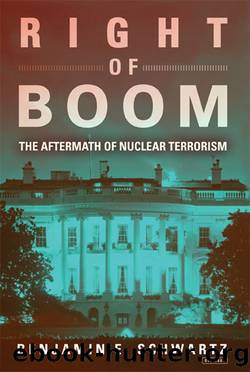Right of Boom by Benjamin E. Schwartz

Author:Benjamin E. Schwartz [SCHWARTZ, BENJAMIN]
Language: eng
Format: epub
ISBN: 9781468311549
Publisher: ABRAMS (Ignition)
Published: 2015-01-01T16:00:00+00:00
COUNTERTERRORISM AS A WAR OF IDEAS
Under president George W. Bush the United States responded to al-Qaeda’s 9/11 attacks by launching a global war aimed at transforming the Islamic world through the promotion of liberal democracy. Many commentators have since charged the administration with radically altering the course of US foreign policy. In truth, the Bush administration looked to its nation’s own history as an explanatory framework from which to understand contemporary events and to find strategies to guide its conduct. Societies tend to construct maps of political geography that highlight distinctions that reflect particular values and historical experiences.10 For example, with the rise of nationalism in the nineteenth century, European society identified the borders of nation-states as the most critical fault lines in the West. At the same time, Europeans often divided the wider world between the “civilized” and “uncivilized”—the West and “the rest.” These lines functioned as the key borders that European statesmen considered when crafting foreign policy.11 With the collapse of Europe’s colonial empires in the twentieth century and the emergence of the Soviet Union, the map of the continent became bifurcated between the democratic and the communist. Neither the nineteenth- nor the twentieth-century paradigms fully reflected reality, but they provided structure and made complexities comprehensible. Arguably, they also identified the fault lines that best defined the political geography of contemporary international politics.
The collapse of the Soviet Union and the end of the Cold War sparked a great debate over what type of maps would define world politics in the twenty-first century. Naturally, visions of the future reflected past experience. Many Europeans predicted the next century would experience a continuance of the “national liberation” struggles that had brought an end to their colonial empires. The French-born doctrine tier mondisme, which held that non-Western societies and states should not be judged by Western standards, contributed to the European projection that nationalism versus empire (or “hegemony”) would define international politics. Looking farther back in history to premodern times, Samuel Huntington argued that the wars of the twenty-first century would be fought along the fault lines of the great civilizations. According to his formulation, culture—which he argued is grounded in religion—would reemerge as the world’s most significant political boundary.
Despite the European origins of the United States, Americans have always perceived international politics differently from the inhabitants of the Old World. To Americans, the differences that Europeans emphasized between France, Prussia, and Spain were always less significant than their commonality. Thomas Paine articulated what most Americans, for most of US history, identified as unifying Old World characteristics: “Every spot of the Old World is overrun with oppression. Freedom hath been hunted round the globe. Asia and Africa have long expelled her. Europe regards her like a stranger and England hath given her warning to depart.”12 Americans tend to see the world as divided between freedom and tyranny. “There are but two sorts of men in the world, freemen and slaves,” declared John Adams.13 Traveling a great distance in time, but not particularly far in substance, one can connect Adams’s words with those of Harry Truman.
Download
This site does not store any files on its server. We only index and link to content provided by other sites. Please contact the content providers to delete copyright contents if any and email us, we'll remove relevant links or contents immediately.
| Arms Control | Diplomacy |
| Security | Trades & Tariffs |
| Treaties | African |
| Asian | Australian & Oceanian |
| Canadian | Caribbean & Latin American |
| European | Middle Eastern |
| Russian & Former Soviet Union |
The Secret History by Donna Tartt(16619)
The Social Justice Warrior Handbook by Lisa De Pasquale(11489)
Thirteen Reasons Why by Jay Asher(7787)
This Is How You Lose Her by Junot Diaz(5768)
Weapons of Math Destruction by Cathy O'Neil(5035)
Zero to One by Peter Thiel(4823)
The Myth of the Strong Leader by Archie Brown(4789)
Promise Me, Dad by Joe Biden(4446)
Stone's Rules by Roger Stone(4415)
Beartown by Fredrik Backman(4414)
How Democracies Die by Steven Levitsky & Daniel Ziblatt(4398)
The Fire Next Time by James Baldwin(4342)
100 Deadly Skills by Clint Emerson(4076)
A Higher Loyalty: Truth, Lies, and Leadership by James Comey(4032)
Rise and Kill First by Ronen Bergman(4012)
The David Icke Guide to the Global Conspiracy (and how to end it) by David Icke(3881)
The Farm by Tom Rob Smith(3872)
Secrecy World by Jake Bernstein(3782)
The Doomsday Machine by Daniel Ellsberg(3730)
